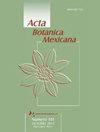加勒比-哥伦比亚国际生物圈保护区海底藻类注释IX:哥伦比亚大叶藻、大叶藻和细叶藻新记录
IF 0.8
4区 生物学
Q4 PLANT SCIENCES
引用次数: 0
摘要
背景和目的:在2019年的海底科学考察期间,在老普罗维登斯和圣卡塔利娜岛周围进行了广泛的海藻收集。尽管在过去十年中进行了大量的生理学研究,但海底生物圈保护区仍有新的大型藻类报告。这项工作的目的是为哥伦比亚提供三种新的褐藻记录。方法:在2019年9月海底科学考察期间进行藻类采样。这些样本是在普罗维登西亚岛和圣卡塔利娜岛附近的珊瑚斑块生态系统中通过水肺潜水在3到16米的深度之间收集的。收集的藻类保存在4%福尔马林/海水溶液中。利用光学显微镜和立体显微镜进行鉴定。所有标本均保存于哥伦比亚国立大学波哥大本文章由计算机程序翻译,如有差异,请以英文原文为准。
Notes on the marine algae of the International Biosphere Reserve Seaflower, Caribbean Colombia IX: new records of Lobophora declerckii, Taonia abbottiana and Verosphacela ebrachia for Colombia
Background and Aims: During the Seaflower Scientific Expedition in 2019, extensive seaweed collection was carried out around Old Providence and Santa Catalina islands. Despite the intensive phycological studies realized during the past decade, new reports of macroalgae are still recorded for the Seaflower Biosphere Reserve. The objective of this work is to present three new records of brown algae for Colombia.Methods: The algal sampling was carried out in September 2019 during the Seaflower Scientific Expedition. The samples were collected around the Providencia and Santa Catalina islands in coral patches ecosystems, by SCUBA diving at depths between 3 and 16 m. The algae collected were preserved in a 4% formalin/seawater solution. The identification was carried out using optical and stereoscopic microscopes. All specimens were deposited in the herbarium JIW of the Biology Department of the Universidad Nacional de Colombia, Bogotá, Colombia. Key results: Three species of brown algae are newly reported for Colombia: Lobophora declerckii, Taonia abbottiana and Verosphacela ebrachia. Verosphacela has been reported, to date, only from the type locality in Florida and from Isla Mujeres, in Mexico. Due to its cryptic and small habit, it may be much more common than actually reported. Lobophora declerckii is apparently the most common species of Lobophora in the Archipelago. Taonia abbottiana may be much more common than reported to date, but it is easily confused with Stypopodium zonale. Conclusions: Despite the intense phycological research carried out in the past decade in the Archipelago of San Andrés, Old Providence and Santa Catalina, there is still much to be discovered.
求助全文
通过发布文献求助,成功后即可免费获取论文全文。
去求助
来源期刊

Acta Botanica Mexicana
生物-植物科学
CiteScore
1.60
自引率
12.50%
发文量
52
审稿时长
>12 weeks
期刊介绍:
Acta Botanica Mexicana da a conocer trabajos originales e inéditos en todas las áreas de la botánica, incluyendo florística, taxonomía, taxones nuevos para la ciencia, ecología, etnobotánica, paleontología, evolución, conservación, etc. Está dirigida a botánicos mexicanos y extranjeros que aporten información en estas áreas del conocimiento, particularmente con plantas nativas del continente americano. Hasta 2018 apareció cuatro veces al año con una periodicidad estricta en la primera semana de enero, abril, julio y octubre; a partir de 2019 se publica de manera continua, sin periodicidad preestablecida, en formato electrónico y de forma gratuita.
 求助内容:
求助内容: 应助结果提醒方式:
应助结果提醒方式:


